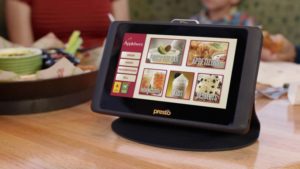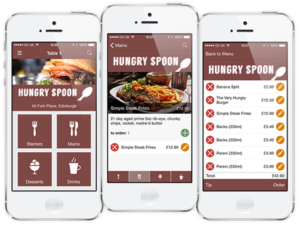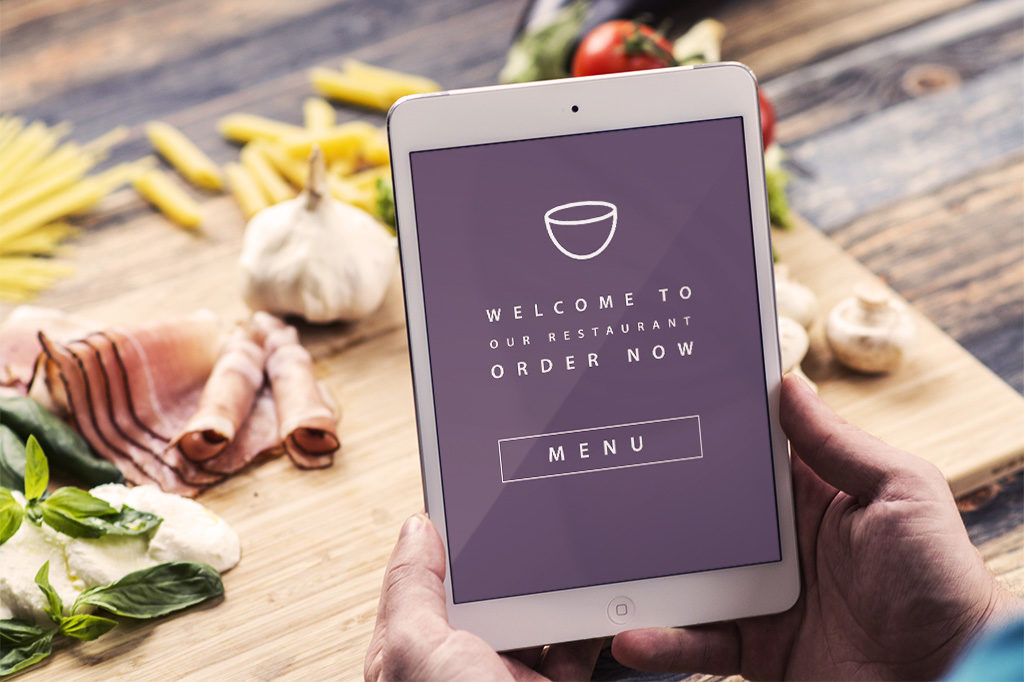Are you a restaurant, hotel, casino or other player in the Hospitality business looking to modernise the order and pay process but find you’re wrestling with the age-old mobile vs. tablet debate? Unsure of which will give you the biggest bang for your buck or deliver the best guest experience? We tackle this issue head on to finally uncover which one – tablet or mobile – should be crowned king of your guest-facing services.
In-store tablets
Applebee’s has embraced in-store tablets in a big way rolling out 100,000 Intel-backed tablets across their stores in the US over the last 18 months. But what does this mean for the customer experience, and more importantly, what do you, as the operator get out of this digital deployment?
Pros
- Save space. With today’s selfie culture, some smartphone users might begrudge apps that aren’t 100% essential, taking up precious photo storage space. In-store tablets with a preinstalled application mean guests don’t have to download an app onto their phone and sacrifice that space.
 Forget your phone. Most people never go anywhere without their mobile, but sometimes that little device is accidentally forgotten, left in another jacket or on the kitchen counter. That’s not a problem when you have in-store devices. Your customers can still enjoy all the benefits of digital order and pay using tablets at the restaurant, hotel, stadium or casino.
Forget your phone. Most people never go anywhere without their mobile, but sometimes that little device is accidentally forgotten, left in another jacket or on the kitchen counter. That’s not a problem when you have in-store devices. Your customers can still enjoy all the benefits of digital order and pay using tablets at the restaurant, hotel, stadium or casino.- A visual feast. Tablets have larger screens and therefore offer a less fiddly and slightly better visual experience than a mobile screen. You’ll be able to show bigger, higher res photos of mouthwatering food and drink so your guests know exactly what they’re ordering, maybe even enticing them to order more.
- Reliable connection. In-store tablets running off secure, private wifi will offer quick, reliable, convenience for your guests. If you don’t provide free wifi and mobile signal is weak, the mobile app may be sluggish leaving your customer frustrated and hungry!
Cons
- Expensive outlay. Equipping each venue with several tablets across your whole estate will get expensive fast. Not to mention the cost of upgrading them when they become old or obsolete which they will in the fast-moving world of tablet hardware.
- Wear and tear. Restaurants, casinos, stadiums and hotels are pretty hostile environments when it comes to public equipment. Drink spills, food, scratches and scrapes, drops and the general wear and tear of being in constant use by your guests mean your tablets will need to be replaced or fixed on a surprisingly regular basis adding that extra cost to your capital expenditure.
- Zero data capture. Unless you give your guests the onerous task of logging in to their own account on the tablet every time they dine with you, you’ll not be able to capture any useful customer information. This information is pretty valuable when it comes to personalised, targeted campaigns and without it your marketing is left in the dark and your loyalty is left limping.
- Too big, too bulky. Having several tablets floating around your venues takes up precious space both on the tables and in busy service areas used by staff.
- Unfamiliar app. If they’re not a regular, guests will need to learn each app from scratch at every restaurant or casino that has their own self-order and pay service. This isn’t a great user experience and may turn the ordering process into a challenge rather than a convenience.
- Limited functionality. In-store tablets can’t provide useful services such as reserving a table in advance or finding the nearest venue. Other capabilities such as social media sharing and recommendations are limited on a shared in-store tablet too with many guests reluctant to login to their accounts on a public device.
- Guests might have reservations inputting payment details on a shared tablet. They’ll also have the added nuisance of needing to fill out payment information with every check rather than enjoying the convenience that pre-stored payment details from a native mobile app affords. Filling in payment details also negates the benefits of the tablet order and pay process which should be faster and more convenient than paying through wait staff. If guests are wasting time typing in long credit card numbers and expiry dates then they might as well flag down a server with a chip and pin machine.
Reviews of table top tablet ordering are a mixed bag with one airport restaurant tablet user explaining:
“I’d say airport tablet ordering was interesting. It would have been more relevant if it was super busy but seemed odd when the waiter was standing there with nothing to do behind the bar. I like the fact there was no pressure to order but didn’t like having to learn the app and it annoyed me that there wasn’t the option to choose a live interaction. I didn’t like the fact I couldn’t order a small drink. Large came as standard. I would have found it more useful to order with mobile if I was short of time and able to do it while waiting in security so I could be sure I had enough time airside for my meal.”
Mobile with self-order app
Het Palais is championing the use of mobile order and pay at Schiphol Airport choosing to capitalise on their guests’ smartphone adoption rather than placing their bets on tablet ordering. But what can mobile offer that tablets can’t?
Pros
 Priceless data capture. A 1:1 device such as a mobile convincingly trumps a 1:many device such as an in-store tablet because of the quality of customer data you can capture as they go through the order and pay process. You can build a clear picture of your customers’ buying behaviour and preferred payment methods which can then drive highly targeted and personalised marketing boosting revenues and loyalty.
Priceless data capture. A 1:1 device such as a mobile convincingly trumps a 1:many device such as an in-store tablet because of the quality of customer data you can capture as they go through the order and pay process. You can build a clear picture of your customers’ buying behaviour and preferred payment methods which can then drive highly targeted and personalised marketing boosting revenues and loyalty.- Additional functionality. Reserve a table, find nearest venue, check-in and make recommendations via social media. These neat added extras bring your restaurant’s app to life turning it into a handy, multidimensional service rather than just another order and payment channel.
- No expensive outlay. No need to spend thousands on kitting out all your stores with expensive tablets that go out-of-date faster than raw fish on a warm day.
- No wear and tear costs. In the unforgiving public environment of a restaurant, hotel, stadium or casino, you don’t need to worry if someone spills hot coffee on your tablets or it gets accidentally knocked off a table. With mobile, guests are responsible for their own hardware removing that cost and concern out of the equation for you.
- App familiarity. Let guests can get familiar with one self-order and pay process across different hospitality venues so they don’t have to learn a new app every time.
- Provide peace of mind to your guests with secure payments within a native mobile application. There’s no need to input payment details every time guests want to close a check as their details are already pre-populated and saved securely within the app.
Cons
- Don’t forget. In order to use the app, customers need to remember their phones!
- Smaller screen. Although phone screens are getting bigger, they’re still not as big as a tablet which means a smaller interface, smaller images and a more fiddly user experience.
- We’ve all had bad reception but I the last place you’d want it is when you’re ravenous and trying to order food. With mobile, if you don’t provide public wifi, there’s the potential for the customer to lose connectivity leaving them high and dry.
Reviews of mobile order and pay for Starbucks and Southwest Grill are overall very positive:
“I have been using the mobile ordering for a while now and LOVE IT! Love not having to wait in any line either to order or to actually get my drink. BEST IDEA EVER! Love it.”
“I have been using the mobile order which has been AWESOME. No waiting in lines order ready. Love it! I generally place my order well in advance so it is there waiting for me and I don’t have to wait at all. Today was the first day my drink wasn’t ready but the barista did mine next so my wait was only for a second or two.”
“I love using the mobile app to order and just walk in to pick it up. I used it multiple times this month and the last experience at this location was very efficient and the wait staff was very friendly.”
The Winner? Although the tablet may provide a slightly better visual experience for the customer, the benefits to the operator are limited. As well as being considerably cheaper, only mobile can give you the personalisation, security and foster the levels of loyalty you need when digitising your order and pay process. So if you’re looking for the best way to digitally transform the customer experience and revolutionise your marketing at the same time, it seems the smart choice is the smartphone!





